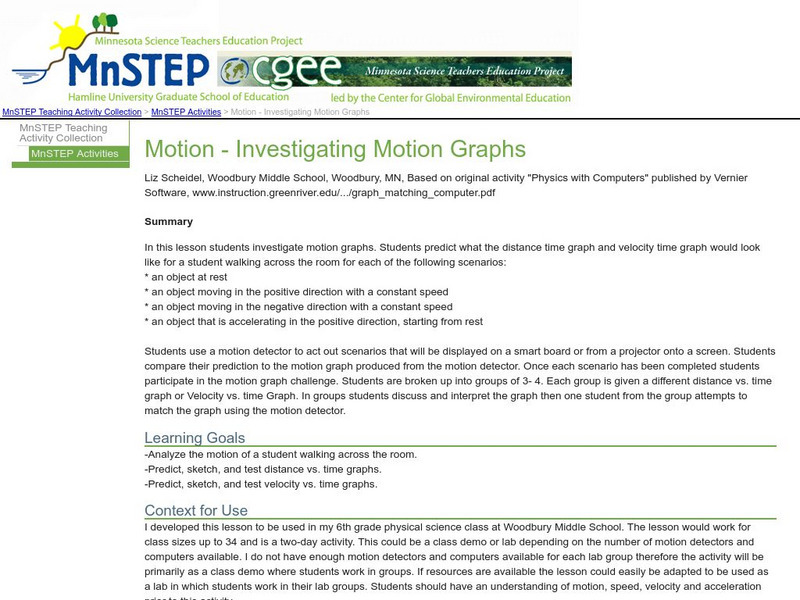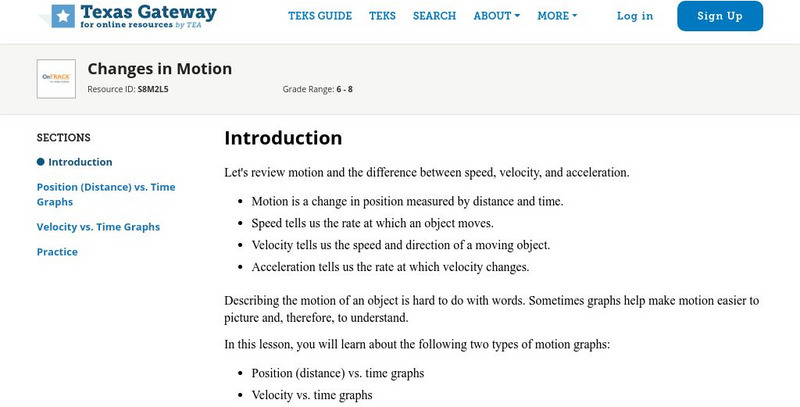Hi, what do you want to do?
Curated OER
Colored Clouds
Fourth graders, in groups, examine how particles in warm water move faster than particles in cold water.
Curated OER
What is Temperature?
Learners examine how temperature is the measure of the average kinetic energy of the molecules of a substance.
Curated OER
Put 3
In this using 'put' in a sentence worksheet, students answer multiple choice questions where they choose the correct word to fill in the blank to the sentence that has the word 'put' in it. Students complete 20 problems.
Curated OER
#22c Airplane flight #22d Airplane flight--How High? How Fast?
Students discuss the application of frames of reference to an airplane flying with a constant velocity v through the air.
Curated OER
#22 Frames of Reference: The Basics
Students explore the concept of frames of reference in physics.
Better Lesson
Better Lesson: Drop and Pop Energy and Speed Exploration
Fourth graders use a toy to make observations that speed is related to the amount of energy in an object as well as work with gravitational and elastic potential energy.
Discovery Education
Discovery Education: Rules of Forces and Motion
With this hands-on lesson plan, help students understand force, gravity, friction, and speed. Students will also learn how each of these concepts affects the another.
Better Lesson
Better Lesson: Collision Course (Part 2)
This is part 2 of a two-part lesson on understanding how speed changes when two objects collide. Students will conduct an experiment, collect data, and draw conclusions about the changes in energy that occur when objects collide....
Sophia Learning
Sophia: Speed & Velocity
A slide show with three accompanying video lesson segments illustrating the difference between speed and velocity, and demonstrating how to calculate average speed and velocity. [6:31]
CK-12 Foundation
Ck 12: Physical Science: Position Time Graphs
[Free Registration/Login may be required to access all resource tools.] How motion and speed can be represented by a distance-time graph and how average speed can be calculated from it.
University of Colorado
University of Colorado: Ph Et Interactive Simulations: Projectile Motion
An interactive simulation that teaches about kinematics, air resistance, and parabolic curve by shooting a car out of a cannon while trying to hit a target. Observe how changes in angle, initial speed, mass, air resistance, and drag...
Better Lesson
Better Lesson: A Change of Direction Exploring the Impact of Forces
Learners will be able to determine a way to change the direction of a moving object by conducting a simple experiment. Included in this lesson are videos of the activity in action, a printable recording sheet, pictures of the set-up for...
Better Lesson
Better Lesson: Falling Objects
Students will determine if objects fall at the same speed by testing a variety of objects as they let them fall from above. They will learn that gravity is the force that is pulling on the object. Included in this lesson is a video about...
BBC
Bbc: Gcse Bitesize: Motion
This lesson focuses on how to calculate average speed and distance traveled. It also explains how to convert different units of measure and provides a link to an assessment.
Science Education Resource Center at Carleton College
Serc: Motion: Investigating Motion Graphs
In this lesson, middle schoolers investigate motion graphs. Students predict what the distance-time graph and velocity time graph would look like for a student walking across the room for three different scenarios.
The Wonder of Science
The Wonder of Science: K Ps2 2: Motion Design Solution
The NSTA vetted source includes resources to teach how to analyze data to determine if a design solution works as intended to change the speed or direction of an object with a push or a pull. Included are assessment ideas, videos,...
American Chemical Society
Middle School Chemistry: Molecules in Motion
Students observe, on a molecular level, how heating and cooling affect molecular motion.
American Chemical Society
Middle School Chemistry: Lesson Plans: Does Temperature Affect Dissolving?
Young scholars identify and control variables to design an experiment to see whether the temperature of a solvent affects the speed at which a solute dissolves.
Physics Classroom
The Physics Classroom: Circular and Satellite Motion: Speed and Velocity
In this interactive module, describe and explain the motion of objects that either move in circles or can be approximated to be moving in circles. Kinematic concepts and motion principles will be applied to the motion of objects in...
Physics Classroom
The Physics Classroom: Circular and Satellite Motion:circular Motion Mathematics
Using the values of speed, acceleration, and force, students explore and analyze the motion of objects in circles.
Texas Education Agency
Texas Gateway: Changes in Motion
In this lesson, you will learn about position vs. time graphs and velocity vs. time graphs and how to use them to solve problems.
Physics Classroom
The Physics Classroom: 1 D Kinematics: Scalars and Vectors
This illustrated tutorial focuses on several examples of vector and scalar quantities including distance, displacement, speed, velocity, and acceleration.
Science Education Resource Center at Carleton College
Serc: Bumps and Buckles: A Lesson on Motion
In this physics lesson, the learners will be learning that motion can be changed when a car goes down a ramp. By adding "speed bumps" in different lengths away from the ramp, they will observe what happens to their car. Students will...
























